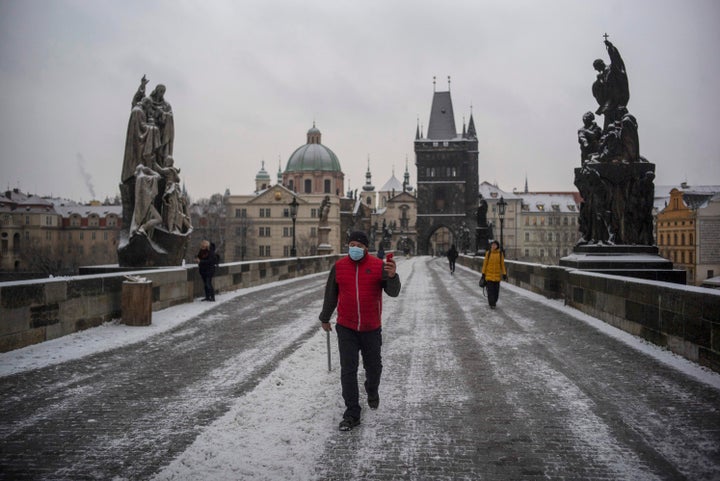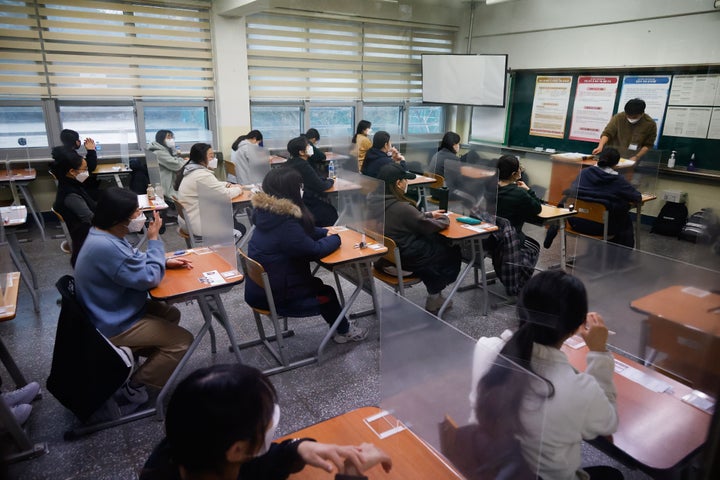The world is losing the battle against the coronavirus. As of last week, COVID-19 caseloads were rising in 115 countries and falling in just 83. Of the countries with rising caseloads, 26 saw new cases double over the previous week.
But the structure of the pandemic shows striking local differences. While the United States is experiencing its third wave of the virus, some countries are just now having their first. Falling temperatures in the Northern Hemisphere, eased restrictions and an overwhelming sense of fatigue are transforming coronavirus superstars into basket cases.
The Czech Republic, for example, was reporting just three COVID-19 deaths per day in August. By November, the figure had soared to over 200 deaths per day. Poland had 475 new cases per day in mid-September. Two months later, it was averaging 25,000.
This pattern of low cases for months before an autumn explosion has played out in every part of the world. Jordan’s caseloads were in the single digits all year, then rose steadily to 54 per day by Sept. 1, then 900 per day by Oct. 1, then up to 3,500 per day by Nov. 1. Turkey’s caseloads have skyrocketed to the point that the graph line is almost vertical, rising tenfold since mid-November.
Even in Asia, where strict lockdowns, widespread testing and diligent contact tracing have kept cases impressively low, Japan and South Korea are now both experiencing alarmingly high infection rates.
So what happened? How did so many countries that managed the first six months of the pandemic so well suddenly drop the ball?
The answer has to do with the changing structure of the pandemic and the shifting incentives for the politicians tasked with managing it. As the coronavirus pandemic approaches its first birthday, both factors will have profound implications for the struggle against the pandemic in the United States.
A Changing Pandemic
Grzegorz Rempala, a mathematical epidemiologist at the Ohio State University, has spent the last three months watching the same pattern play out in Ohio, where he lives, and in Poland, where he grew up. After a long stretch of low caseloads, COVID-19 exploded in both places in the late summer.
The explanation, he said, is the shifting structure of the pandemic. In the spring, infections were clustered among high-risk groups: health care staff, nursing home residents, prisoners and essential workers. The virus hopped from cluster to cluster but remained relatively concentrated in workplaces and urban areas.
Over the summer, however, the virus generalized. Essential workers brought the virus home to their families, travelers spread it around the country and churches and other large gatherings became superspreader events. The virus remained at low levels in the population, but it spread to younger populations and suburban and rural areas — many of which hadn’t experienced widespread infection earlier in the year.
“For months, huge regions of Europe and the U.S. didn’t see very many COVID deaths or cases,” Rempala said. “People knew they were supposed to be masking and social distancing, but many of them simply chose not to because they didn’t know anyone who had tested positive.”

The risk of contracting a virus is intrinsically linked to its prevalence in the population. In both Poland and Ohio, people could gradually expand their social networks and take on riskier activities like meeting indoors and going to restaurants without a significant chance of encountering an infected person.
But as summer turned to fall, those activities became exponentially riskier. The end of the summer meant falling temperatures, students returning to campuses and, in many countries, a huge spike in holiday travel. Populations may have been able to weather one of these factors separately, but all of them at once pushed infections past the point of no return.
“You can’t point to any single factor and say, ‘That’s it,’” said Brandon Guthrie, an epidemiologist at the University of Washington and the director of the COVID-19 Situation Report. “It’s the culmination of a lot of small things, each of which increased the risk of transmission slightly. Then we reached a tipping point.”
Trying To Bargain With The Virus
Bad political management also played a role, as leaders around the world began to relax restrictions on social and economic activities too quickly.
The Czech Republic, for example, controlled the virus in the early stages with one of the world’s most comprehensive mask mandates. New daily cases peaked in March at 408, then stayed under 100 until late June. Believing they had beaten the virus, government leaders lifted the mask mandate, reopened borders to travelers and legalized gatherings of up to 300 people. Prague hosted a “farewell coronavirus” celebration in June.
Almost immediately, however, cases started ticking upwards. By late August, they had reached 300 per day. By late September, they had passed 2,000 per day. Despite the worsening indicators, Prime Minister Andrej Babis delayed restricting public events, closing businesses and shutting down schools until October. Critics claim he was waiting until after a Senate election to impose the most stringent restrictions.
“There’s a sense of fatigue among politicians and populations alike,” Guthrie said. “A lot of places that reduced transmission by closing businesses and restricting other activities started to relax those restrictions over the summer and early fall. They’re now struggling with the decision of if and how to reimpose restrictions.”
“We’ve moved into the phase of the pandemic where a lot of transmission is driven by what’s going on in individual people’s homes. And at the same time, we’ve gotten desensitized to how many deaths we’re seeing every day.”
- Brandon Guthrie, epidemiologist at the University of Washington
Trying to find the balance between restricting social activities and restarting economic activity is a major reason the virus remains so resilient. In Hong Kong, officials imposed a 14-day quarantine on travelers over the summer but exempted airline employees and executives of stock-market listed companies. In South Korea, the government moved forward with nationwide student exams this week despite the risks of indoor transmission. Norway is telling citizens that they can have Christmas gatherings of up to 10 people.
“Some of the highest risk activities are the ones that people crave and employ a lot of people,” Guthrie said. Lockdown orders and other restrictions have provoked backlash in countries that handled the coronavirus well and poorly alike.
“From a public health perspective, it’s clear that closing bars and restaurants will immediately decrease the spread of the virus,” Rempala said. “But at this point, health officials risk a larger political backlash than they got in the spring.”

A Hard Road Ahead
The height and duration of COVID-19’s third wave — or, in some countries, the first wave — remains unclear.
On the optimistic side of the ledger, the current surge appears to be less deadly than it was in the spring. This is partly due to the expansion of hospital capacity, doctors’ growing expertise, and improved pharmaceutical treatments. Some data indicate that face masks and social distancing have resulted in lower viral loads for infected patients. All of these factors have significantly reduced fatality rates.
In less-optimistic news, the virus may be becoming harder to control. The demographics of coronavirus infection are skewing younger. In Japan, people in their 20s make up the largest share of new infections, a shift that makes asymptomatic spread more likely. Most countries with rising caseloads don’t have enough contact tracing to identify where infections are coming from, much less control them. Plus, the coronavirus is about to intersect with flu season, a complicating factor that could push death rates higher.
“We’ve moved into the phase of the pandemic where a lot of transmission is driven by what’s going on in individual people’s homes,” Guthrie said. “And at the same time, we’ve gotten desensitized to how many deaths we’re seeing every day.”
The introduction of a coronavirus vaccine represents yet another layer of complexity. Doses are already arriving at American airports, but it’s not clear how they will be distributed domestically, much less internationally.
“The things we need to do to control the virus aren’t things we have to do forever,” Guthrie said. “We just have to do them until we have large-scale access to the vaccine. That’s the closest thing we have to good news these days.”
- Which airlines are blocking out middle seats for holiday travel?
- How does the coronavirus spread differently than the flu?
- Can you close your COVID “bubble” without losing friends forever?
- Is it safe to see grandparents over the holidays?
- How can you help a friend with anxiety when you’re also struggling?
Everyone deserves accurate information about COVID-19. Support journalism without a paywall — and keep it free for everyone — by becoming a HuffPost member today.

